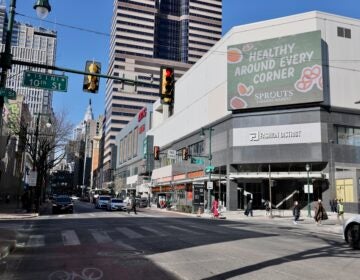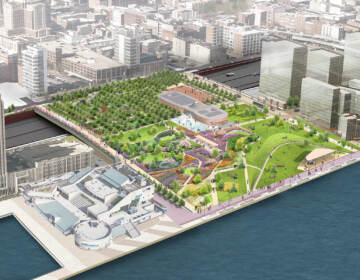Squilla calls increased Delaware waterfront height limit ‘progressive’ – waterfront advocates say it would undercut plan

Harris Steinberg fears that Philadelphia’s Delaware waterfront may be returning to the bad old days.
Almost 10 years ago, when Steinberg ran PennPraxis, he presented a civic vision for seven miles of the central Delaware waterfront to a standing room crowd of 1,500 people. It was the culmination of a process that lasted over a year, featured 200 meetings, and was attended by more than 4,000 people.*
The vision PennPraxis presented that day would eventually lead to the creation of a master plan and a zoning overlay to align redevelopment with the community’s vision for the waterfront between Oregon and Allegheny avenues and east of I-95. The overlay, which gives weight to the principles of the plan, passed City Council in 2013 after two years of talks between Councilman Mark Squilla, waterfront advocates, planners, developers, and property owners.
Now Councilman Squilla has introduced a bill that would substantially revise the height bonuses available under the Central Delaware Overlay.
Currently the maximum allowable height is capped, with bonuses, at 244 feet. (The base height limit is 100 feet.) The plan recommended a height limit, arguing it would help prevent an rapid, over-saturated housing market and incentivize development to be spread along the whole riverfront. Planners and waterfront advocates also feared a cycle of high-cost, high-rise proposals would drive up land values while the ambitious and expensive plans floundered.
There is precedent for that fear. Back in 2007 PlanPhilly reported that 20 high-rise towers hosting 5,000 condos were planned for the Delaware riverfront. When we followed up in 2013, after the overlay had just passed, not a single one of these new units had been built.
To Steinberg and many of the stakeholders involved in the visioning process and the last decade of advocacy, it looks as though the master plan will be undone by Squilla’s amendment. The impetus for the legislation is a mega-project of the kind that the drafters of the overlay were wary of—a ten-tower project from K4 Associates, slated for the current site of the Sheet Metal Workers Local 19 union hall just below Washington Avenue.
“This legislation flies in the face of a decade-long public planning process,” says Steinberg. “To modify all that with a stroke of the pen for one project is a real slap in the face to the public’s voice for determining the future of the city.”
The ire is not limited to Steinberg. The Central Delaware Advocacy Group (CDAG), in particular, is displeased in the extreme. Squilla’s bill provoked a scathing response as well from the Philadelphia Inquirer’s architecture critic, Inga Saffron.
But Squilla sounded utterly mystified when PlanPhilly asked him, on the council floor Thursday, about the heated reaction to his bill. He says his office made CDAG and the Delaware River Waterfront Corporation aware of the legislation before he introduced it and that there will be meetings with both groups to discuss possible amendments before the June 13 Rules Committee hearings.
“They are well aware of what’s going on, so I don’t think there is any controversy,” said Squilla. “It’s being progressive, as we are here on council. We look at things as they progress. We are looking for new opportunities to help spur development even more on the Central Delaware.”
The bill would expand the public space height bonus available anywhere in the Central Delaware Overlay to 48 additional feet from the current maximum bonus of 24 additional feet. It would also allow new height bonuses of 48 feet for efficient stormwater management and for offering connections to the riverfront to the public. Overall the size of the height bonuses is being increased from 144 to 216 feet above the base height (which remains the same).
Squilla says the massive new housing development planned by K4 Associates — ten towers on 18-acres — is what brought his attention to the need to change the overlay. The first phase of the project, featuring a 22-story, 264-unit building, is permissible under the current overlay. But later phases, which call for higher towers, would not be.
A proposal for a bill of this nature has been in the works since 2016.
“We’ve been working with them over a year to get somewhere,” says Anne Fadullon, the city’s director of planning and development. “The ordinance we got originally from the development team was 30 pages long and asked for over 20 changes and we said ‘absolutely not.’”
Fadullon says the city was not interested in making a change to the overlay only around the K4 site, as the developer originally suggested, and it also resisted calls to increase the base height without bonuses from 100 feet. As an alternative, the Planning Commission worked with Squilla’s office to develop changes to the overlay as a whole, but restricted those to creating a more generous bonus structure.
“This really isn’t our bill, this is the councilman’s bill,” said Fadullon.
The Planning Commission encouraged the developer to meet with community groups like CDAG and the Pennsport Civic Association. Meetings have been held between K4 Associates and these groups about the larger project, but key stakeholders still felt surprised and disheartened when Squilla shared his bill.
“What’s concerning is that the bill got introduced before CDAG could comment on its details,” says Joe Schiavo, vice-chair of CDAG. “This isn’t how to start a dialogue. It disadvantages anyone who wasn’t part of initiating the bill because you are chasing it down its path to passage. That’s the only thing you can do once a bill has been introduced.”
Schiavo and CDAG chairman Matt Ruben both critiqued the content of the bill extensively. They claim that riverside projects already have an easier time with stormwater management than sites almost anywhere else in the city, which is why such height bonuses were left out of the existing overlay. Height bonuses for public access were also intentionally left out of the overlay, because any parcel large enough to necessitate such a thing should offer it anyway.
“I know the logic behind each and every one of those bonuses, why they were included, and which weren’t,” says Schiavo. “These bonuses are there for doing something that is good for the city, something that you don’t otherwise have to do. But they are plugging in bonuses for things you have to do anyway.”
With less than a month before the Rules Committee hearing on a bill that’s been over a year in the making, Ruben, Schiavo, and their compatriots feel left out of the process of reforming a document they spent years working on with Councilman Squilla and the Planning Commission.
Reached for comment, representatives of the Delaware River Waterfront Corporation (DRWC) retained a scrupulously neutral tone. Like CDAG, the organization had the bill only a few days in advance. But DRWC hadn’t realized it would be introduced within the week. It is reviewing the legislation now.
“If we have a real conversation, we could add amendments and we could have something good or at least something acceptable,” says Joseph Forkin, vice-president for operations and development at DRWC. “If that conversation does not take place in a good or productive way then this is not a good thing for the overlay.”
For Squilla, this bill is simply reflective of the idea that the overlay should be a living document that is subject to change.
“We are looking at this as a true example of continued collaboration with DRWC, CDAG, and community groups along the river,” says Squilla. “You have to be willing to change with the times. We are seeing that what we have there now is causing a little development, but not that big push we thought we’d get initially.”
Though many developments have been proposed, only one large new project has been constructed so far under the overlay, One Water Street. The rest of the new housing built has been limited to townhouse developments.
Schiavo believes the overlay is working as intended, while Forkin says that the state of development isn’t being harmed by the current overlay—although he does wish there was more investment on the river.
Looking back on the civic visioning process Steinberg, the former PennPraxis chief now at Drexel’s Lindy Institute, remembers how things could have been. He would like to see the city revisit the possibility of extending the street grid to the river, one of the policy proposals put forward in the civic visioning process that never came to be. (Much of the land is privately owned.) If the grid had been extended, he argues, height bonuses couldn’t be offered for things like providing public riverfront access.
Now Steinberg fears the fruits of that decade of public planning and public participation are in danger. No matter the outcome, he believes the process deserved more than legislation largely crafted without public input.
“This is councilmanic prerogative rearing its ugly head,” says Steinberg. “This could be the thread that pulls the whole thing apart. Fiddling with it, messing with it, potentially upending it. This could set Philadelphia back decades.”
*NOTE: PlanPhilly was born out of the civic visioning process and was incubated at PennPraxis until 2015.
WHYY is your source for fact-based, in-depth journalism and information. As a nonprofit organization, we rely on financial support from readers like you. Please give today.







